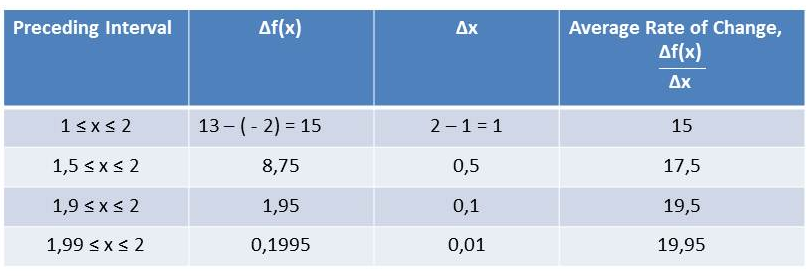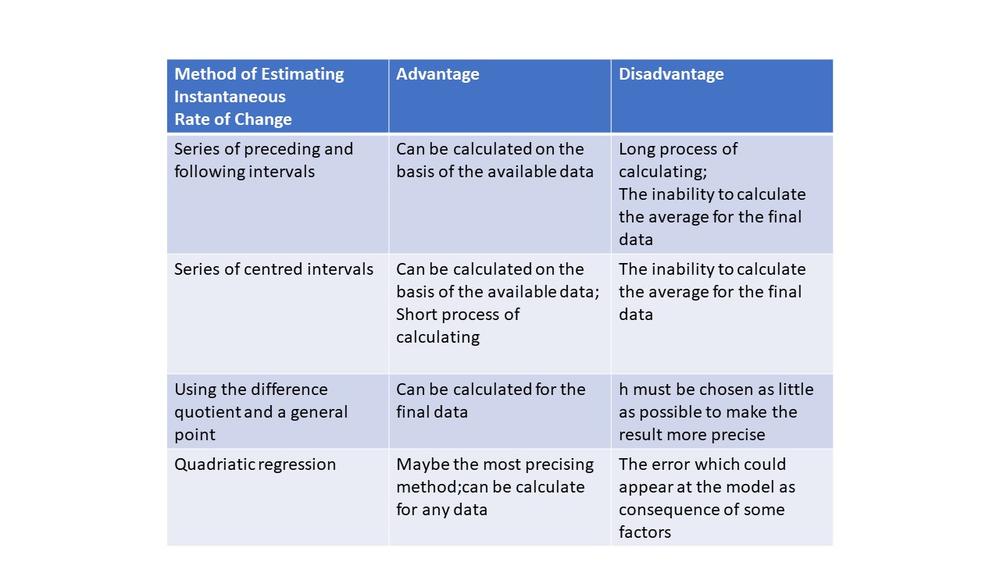
All Solutions
Section 2-2: Estimating Instantaneous Rates of Change from Tables of Values and Equations


Here, we will use intervals $1.99leq{x}leq2$ and $2leq{x}leq2.01$ because, they are the smallest intervals on either side of $x=2$ so, according to previous explanation on pages $80$ and $81$, we have $textbf{the instantaneous rate of change when}$ $x=2$ is:
$dfrac{19.95+20.05}{2}=dfrac{40}{2}=20$
Here, using the preceding and following interval method, according to earlier explanations, we have next:
First, let’s find average rate of change on interval $1.5leq{t}leq2$:
$dfrac{Delta{f(t)}}{Delta{t}}=dfrac{30.9-26.98}{2-1.5}=dfrac{3.92}{0.5}=7.84$
Now, let’s find average rate of change on interval $2leq{t}leq2.5$:
$dfrac{Delta{f(t)}}{Delta{t}}=dfrac{32.3830.9}{2.5-2}=dfrac{1.48}{0.5}=2.96$
And finally, $textbf{the instantaneous rate of change in the height of the ball at exactly }$ $t=2$ is:
$$
dfrac{7.84+2.96}{2}=5.4
$$
#### (b)
Here, using the centred interval method, we will use interval $1.5leq{t}leq2.5$, because it is the smallest of given intervals which contains $t=2$, and we have that $textbf{ the instantaneous rate of change in the height of the ball at exactly }$ $t=2$ is:
$dfrac{32.38-26.98}{2.5-1.5}=5.4$
#### (c)
I prefer $textbf{the centred interval method}$ because it easier and simplier to calculate $textbf{the instantaneous rate of change}$.
$textbf{The population of raccoons at $2.5$ months will be:}$
$P(2.5)=100+30cdot2.5+4cdot2.5^2=200$
#### (b)
$textbf{The average rate of change in the raccoon population
over the interval}$ $0leq{t}leq2.5$ will be:
$textbf{average rate of change}$ = $dfrac{P(2.5)-P(0)}{2.5-0}=dfrac{200-100}{2.5}=40$
#### (c)
$textbf{The rate of change in the raccoon population at exactly
$2.5$ months is}$:
$dfrac{P(2.51)-P(2.49)}{2.51-2.49}=dfrac{100.5004-99.9004}{0.02}=30$
#### (d)
Answers for parts (a), (b), and (c) are different because at each part we calculated different things.At part (a) it was total population at $t=2.5$, at part (b) it was the average number by which the population has changed from moment $t=0$ to moment $t=2.5$, and at pasrt (c) we calculated change in the number at exactly $t=2.5$.
Here, we will use interval $-2.01leq{x}leq-1.99$ to estimate the $textbf{instantaneous rate of change}$ at $x=-2$:
$$
begin{align*}
textbf{instantaneous rate of change} &= dfrac{6cdot(-1.99)^2-4-(6cdot(-2.01)^2-4)}{-1.99+2.01}\
&=dfrac{23.7606-24.2406}{0.02}\
&=-24\
end{align*}
$$
#### (b)
Here, we will use interval $-0.01leq{x}leq0.01$ to estimate the $textbf{instantaneous rate of change}$ at $x=0$:
$$
begin{align*}
textbf{instantaneous rate of change} &= dfrac{6cdot(-0.01)^2-4-(6cdot(0.01)^2-4)}{0.01+0.01}\
&=dfrac{0}{0.02}\
&=0\
end{align*}
$$
#### (c)
Here, we will use interval $3.99leq{x}leq4.01$ to estimate the $textbf{instantaneous rate of change}$ at $x=4$:
$$
begin{align*}
textbf{instantaneous rate of change} &= dfrac{6cdot4.01^2-4-(6cdot3.99^2-4)}{4.01-3.99}\
&=dfrac{96.4806-95.5206}{0.02}\
&=48\
end{align*}
$$
Here, we will use interval $7.99leq{x}leq8.01$ to estimate the $textbf{instantaneous rate of change}$ at $x=8$:
$$
begin{align*}
textbf{instantaneous rate of change} &= dfrac{6cdot8.01^2-4-(6cdot7.99^2-4)}{8.01-7.99}\
&=dfrac{384.9606-383.0406}{0.02}\
&=96\
end{align*}
$$
instantaneous rate of change in the object’s height at}$ $x=3 s$ is:
$$
begin{align*}
textbf{the instantaneous rate of change}&=dfrac{-5cdot3.01^2+3cdot3.01+65-(-5cdot2.99^2+3cdot2.99+65)}{3.01-2.99}=\
&=dfrac{-36.2705+35.7305}{0.02}\
&=-27\
end{align*}
$$
instantaneous rate of change in the home’s value at the start of the
eighth year of owning the home, and we have next:
$textbf{instantaneous rate of change}$=$$dfrac{125000(1.06)^{8.01}-125000(1.06)^{7.99}}{8.01-7.99}$=11608.974
$$
\
$$
Here our interval is $2000leq{t}leq2024$, and the average rate of change in the population is:
$textbf{average rate of change}$ = $dfrac{P(2024)-P(2000)}{2024-2000}=-6000$
#### (b)
It means that number of people is getting smaller, in average, for $6000$ ther ewill be less people from $2000$ to $2024$.
#### (c)
First, we have $textbf{average rate of change}$ from $2000$ to $2012$:
$textbf{average rate of change}$ = $dfrac{P(2012)-P(2000)}{2012-2000}=-5982$
Now, we have $textbf{average rate of change}$ from $2012$ to $2012$:
$textbf{average rate of change}$ = $dfrac{P(2024)-P(2012)}{2024-2012}=-6018$
To prove part (b), we have that average rate of change in the population from $2000$ to $2024$, including results from this part is really $6000$:
$textbf{average rate of change}$ = $dfrac{-5982-6018}{2}=-6000$
#### (d)
$textbf{The instantaneous rate of change in the population }$ will be $0$ for $t=2000$.
rate of change}$ in the value of the car when the car is $5$ years old:
$textbf{the instantaneous rate of change}$ = $dfrac{V(5.01)-V(4.99)}{5.01-4.99}=-959.5$
It means that the price of the car at the moment $t=5$ years is for $959.5
$$
lower.\
$$
The time when the diver will enter the water, $t$, we will find $textbf{solving following quadriatic equation}$:
$0=10+2t-4.9t^2$
Here, the height above the water, function $h(t)$, is $0$ at the moment when the diver enters the water. And, solving this quadriatic equation, we get that $textbf{diver will enter the water for}$ $t=1.65 s$.
#### (b)
Here, we will estimate the rate at which the diver’s height above the water is changing as the diver enters the waterm using following formula for speed, $v$.
$v=dfrac{s}{t}=dfrac{10}{1.65}=6.06$ m/s
Here, $s$ is $10m$, that is height of the diver above the water, and $t$ is the time we found in part (a), $textbf{so the solution is}$ $6.06$ m/s.
$textbf{average rate of change}$=$dfrac{V(5)-V(4.99)}{5-4.99}=100$
Now, we will calculate it on interval $5leq{r}leq5.01$:
$textbf{average rate of change}$=$dfrac{V(5.01)-V(5)}{5.01-5}=100$
Now, we will estimate $textbf{the instantaneous rate of change}$ in the volume of the snowbal for $r=5$:
$textbf{the instantaneous rate of change}$=$dfrac{100+100}{2}=100$
The second method will be $textbf{the centered interval method}$, we will use interval $4.99leq{r}leq5.01$:
$textbf{the instantaneous rate of change}$=$dfrac{V(5.01)-V(4.99)}{5.01-4.99}=100$
Here, we will use $textbf{centred interval method}$, we will take interval $3leq{t}leq5$, for $t=4$ min, so we have that $textbf{the instantaneous rate of change in the temperature of the oven at exactly}$ $t=4$ is:
$$
dfrac{Delta{T}}{Delta{t}}=dfrac{305-350}{5-3}=-22.5^circ F/min
$$
#### (b)
Using quadratic regression, $textbf{an equation which represent the data}$,
rounding to two decimal places, is the model:
$f(t)=-1.96t^2-9.82t+400.71$,
where $f(t)$ is oven temperature and $t$ is time.
Now, we will calculate the average rate of change in oven temperature using a very small centred interval near $t=4$, let’s take interval $3.99leq{t}leq4.01$. The instaneous rate of change in temperature at $5$ min is:
$dfrac{Delta{f(t)}}{Delta{t}}=dfrac{f(4.01)-f(3.99)}{4.01-3.99}=-104^circ F/min$
#### (c)
$textbf{Our answers are different because we used different intervals}$.
#### (d)
$textbf{The better estimate is at part (b)}$ because we used much smaller interval, so, and estimate is much better.

Let’s first calculate area of the circle for $r_1=0$ cm:
$P_1=r_1^2pi=0^2pi=0 cm^2$
Now, we will find area of the circle for $r_2=100$ cm:
$P_2=r_2^2pi=100^2pi=10000pi cm^2$
Next, we will find $textbf{average rate of change in the area for one circle}$:
$textbf{average rate of change}$ = $dfrac{P_2-P_1}{r_2-r_1}=dfrac{10000pi-0}{100-0}=100pi$
#### (b)
Let’s first calculate area of the circle for $r_1=119.99$ cm:
$P_1=r_1^2pi=119.99^2pi=14376.01 cm^2$
Now, we will find area of the circle for $r_2=120.01$ cm:
$P_2=r_2^2pi=120.01^2pi=14402.4001pi cm^2$
Now, we will find $textbf{instaneous rate of change in the area}$, in order to find how fast is the area changing when the radius is $r=120$ cm:
$dfrac{Delta{P}}{Delta{r}}=dfrac{P_2-P_1}{r_2-r_1}=1319.505pi$
$P_1=6a_1^2=6cdot{2.99^2}=53.6406cm^2$
Now, we will find area of a crystal in the shape of a cube for the side length of the crystal is $a_2=3.01$ cm:
$P_2=6a_2^2=6cdot{3.01^2}=54.3606cm^2$
Finally, we will $textbf{estimate instaneous rate of change}$ at which the surface area is changing when the side length of the crystal is $r=3$ cm:
$dfrac{Delta{P}}{Delta{a}}=dfrac{54.3606-53.6406}{3.01-2.99}=36$
$P_1=4r_1^2pi=4cdot{19.99^2}pi=1598.4004 cm^2$
Now, we will find area of a spherical balloon when its radius is $r_2=20.01$ cm:
$P_2=4r_2^2pi=4cdot{20.01^2}pi=1601.6004 cm^2$
And finally, we will $textbf{estimate the instaneous rate at which its surface area is changing}$ when the radius is $r=20$ cm:
$dfrac{Delta{P}}{Delta{r}}=dfrac{P_2-P_1}{r_2-r_1}=160$

